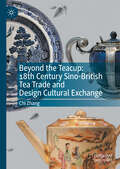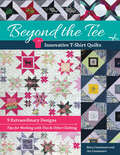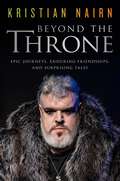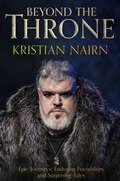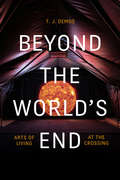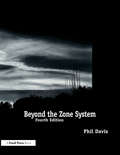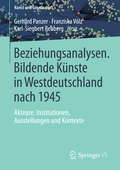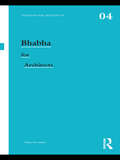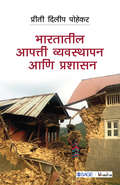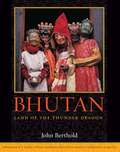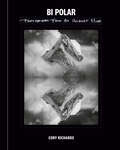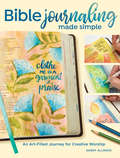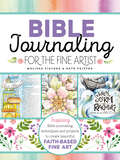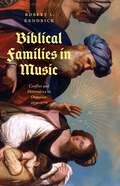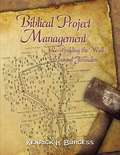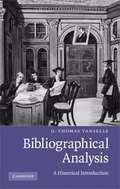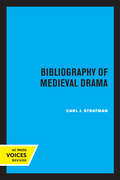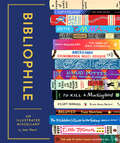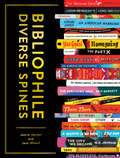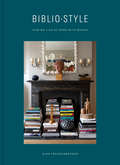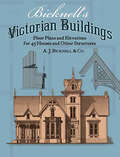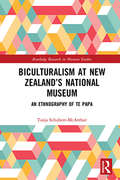- Table View
- List View
Beyond the Teacup: 18th Century Sino-British Tea Trade and Design Cultural Exchange
by Chi ZhangThis book focuses on tea-ware design exchanges between China and the UK since the middle of 17th Century, and explores how design encouraged trade and how the market demand influenced the development of design. The spirit of Chinese tea came to Britain alone with tea itself, and enriched the design of tea-ware, as well as British tea culture. During this process, tea-related oriental aesthetics evolved into an aesthetic image mechanism and developed as aesthetic concept, which infiltrated from private space to social space.
Beyond the Tee: 9 Extraordinary Designs
by Mary Cannizzaro Jen Cannizzaro&“An exciting intro to the craft of making quilts using fabric from T-shirts . . . This how-to will be a boon to any quilter looking for a new challenge.&” —Publishers Weekly Expand your idea of what a T-shirt quilt can be! Create nine innovative projects from T-shirts, clothing solids, prints, motifs, onesies, ties—anything goes. Learn how to cut into clothing and maximize your fabric, even altering a design to fit special tees. Solve common challenges like motifs separated by zippers and logos that are too big or too small. With a few T-shirt quilt basics under your belt, and the designs and tips in this guide, you&’ll soon become an expert at preserving the past.
Beyond the Throne: Epic Journeys, Enduring Friendships, and Surprising Tales
by Kristian NairnBeyond the Throne is the first memoir to share behind‑the‑scenes stories of the perils and triumphs of Game of Thrones—from beloved performer Kristian Nairn, who played Hodor and became one of the most recognizable figures of the global television phenomenon.The story of an unlikely hero who fulfilled his destiny… Fans will be fascinated by Kristian Nairn&’s experience on Game of Thrones, from his unlikely audition to his on-the-job training as an actor to his ascendance as one of the most beloved and pivotal characters on the show. Nairn details the camaraderie that develops as the actors face the elements on set, not entirely unlike the ones their characters must endure on screen, as well as the life-altering effects of worldwide stardom. Nairn&’s personal story—raised by a single mother during the Troubles in Ireland, coming of age as a gay man in Lisburn and Belfast, navigating intolerance, and seeking out his scene—is an epic, often rollicking, sometimes heartbreaking journey all its own. Nairn finds his voice and his confidence performing as a drag queen called Revvlon, and eventually DJing at the legendary nightclub Kremlin. Through the pitfalls and revelations of his creative pursuits, Nairn comes to understand who he really is, and that he is enough—a message that will resonate for anyone who has struggled to find their place.
Beyond the Throne: Epic journeys, enduring friendships and surprising tales
by Kristian NairnBeyond the Throne is the first memoir to share behind‑the‑scenes stories of the perils and triumphs of Game of Thrones from beloved performer Kristian Nairn, who played Hodor and became one of the most recognizable figures of the global television phenomenon.The story of an unlikely hero who fulfilled his destiny...Fans will be fascinated by Kristian Nairn's experience on Game of Thrones, from his unlikely audition to his on-the-job training as an actor to his ascendance as one of the most beloved and pivotal characters on the show. Nairn details the camaraderie that develops as the actors face the elements on set, not entirely unlike the ones their characters must endure on screen, as well as the life-altering effects of worldwide stardom.Nairn's personal story-raised by a single mother during the Troubles in Ireland, coming of age as a gay man in Lisburn and Belfast, navigating intolerance, and seeking out his scene-is an epic, often rollicking, sometimes heart-breaking journey. Nairn finds his voice and his confidence performing as a drag queen called Revvlon, and eventually DJing at the legendary nightclub Kremlin. Through the pitfalls and revelations of his creative pursuits, Nairn comes to understand who he really is, and that he is enough-a message that will resonate for anyone who has struggled to find their place.
Beyond the World's End: Arts of Living at the Crossing
by T. J. DemosIn Beyond the World's End T. J. Demos explores cultural practices that provide radical propositions for living in a world beset by environmental and political crises. Rethinking relationships between aesthetics and an expanded political ecology that foregrounds just futurity, Demos examines how contemporary artists are diversely addressing urgent themes, including John Akomfrah's cinematic entanglements of racial capitalism with current environmental threats, the visual politics of climate refugees in work by Forensic Architecture and Teddy Cruz and Fonna Forman, and moving images of Afrofuturist climate justice in projects by Arthur Jafa and Martine Syms. Demos considers video and mixed-media art that responds to resource extraction in works by Angela Melitopoulos, Allora & Calzadilla, and Ursula Biemann, as well as the multispecies ecologies of Terike Haapoja and Public Studio. Throughout Demos contends that contemporary intersections of aesthetics and politics, as exemplified in the Standing Rock #NoDAPL campaign and the Zad's autonomous zone in France, are creating the imaginaries that will be crucial to building a socially just and flourishing future.
Beyond the Zone System
by Phil DavisThis fourth edition of Beyond the Zone System makes the science of photographic sensitometry both accessible and useful to interested photographers. It will appeal to any serious photographer interested in knowing how the materials and processes of black-and-white photography work. Instead of describing rote procedures to be followed blindly, this book provides the basis for understanding what needs to be done and why. This book relates theory to practice in a way that promotes a true partnership of science and art. Beyond the Zone System bridges the gap between the more theoretical aspects of the photographic process and the popular empirical procedures used by many photographers in the attempt to predict and control the quality of their photographs in practice.This book is intended primarily for photographers who use large-format cameras and black-and-white sheet film, but the basic information about how the B&W photographic materials and processes work will be useful to users of any B&W film format.Beyond the Zone System, 4th ed. will appeal to any serious photographer interested in knowing how the materials and processes of black-and-white photography work. Instead of describing rote procedures to be followed blindly, this book provides the basis for understanding what needs to be done and why. This book relates theory to practice in a way that promotes a true partnership of science and art.
Beziehungsanalysen. Bildende Künste in Westdeutschland nach 1945: Akteure, Institutionen, Ausstellungen und Kontexte (Kunst und Gesellschaft)
by Gerhard Panzer Franziska Völz Karl-Siegbert RehbergAb den fünfziger Jahren entstand in Westdeutschland mit der neu geschaffenen ,,documenta" allmählich das Bild einer eigenständigen ,,Westkunst". Unter neuen politischen Rahmenbedingungen bewegte sich die Kunstwelt zwischen Versuchen, an Vorkriegstraditionen anzuknüpfen und sich zu modernisieren. Es kanonisierten sich abstrakte Gegenwartstendenzen, welche in der Gegensatzspannung zum Osten zunehmend politisch instrumentalisiert wurden. Von den Zeitgenossen schon kontrovers diskutiert, wird diese Phase der Kunstentwicklung bis heute unterschiedlich bewertet. Der vorliegende Band versammelt historisch-empirische Analysen, die die Beziehungsgeflechte in der damaligen Kunstwelt und deren strukturbildende, dynamische Vernetzung mit der Gesellschaft untersuchen, wobei die sozialen Träger dieser Erfolgsgeschichte im Mittelpunkt stehen.
Bhabha for Architects (Thinkers for Architects)
by Felipe HernandezThe work of Homi K. Bhabha has permeated into numerous publications which use postcolonial discourse as a means to analyze architectural practices in previously colonized contexts, particularly in Africa, Asia, the Middle-East, South-East Asia and, Latin America. Bhabha's use of the concept of ‘space’ has made his work highly appealing to architects and architectural theorists. This introductory book, specifically for architects, focuses on Bhabha’s seminal book The Location of Culture and reveals how his work contributes to architectural theory and the study of contemporary architectures in general, not only in colonial and postcolonial contexts.
Bharata: The Natyasastra
by Kapila VatsyayanThe attempt has been to review the Natyasastra as an important confluence in the perennial flow of the tradition with the twin processes of continuity and change, as also of the interplay of the sastra and the prayoga, not to speak of the integral vision which provides a unity of purpose and rigorousness of structure to the text.
Bharatatil Aapatti Vyavasthapan va Prashasan
by Priti Diliprao PohekarDisaster Management is a critical and integral part of any government’s planning strategy. Indian government has been struggling with it since long. This book discusses the varied threats, risks that the country faces. It talks about the Acts implemented, their advantages/disadvantages and their validity. It also talks about the different stakeholders involved, role players and decision makers in the country. It compare country’s disaster management with international decisive moments and acts and the UN’s ordinance.
Bhutan
by John Berthold His Eminence Lyonpo Thinley GyamtshoRegarded as the "crown jewel of the Himalayas," the Kingdom of Bhutan is the last remaining independent country to support Buddhism as the official state religion. Photographed over the course of three years, Bhutan: Land of the Thunder Dragon transports us to colorful festivals and religious traditions, continuing to the remote communities along the roof of the world. This book encompasses a wide range of landscape, portrait, and editorial photographs sure to impress and please any reader interested in travel, photography, and/or Himalayan culture.
Bi-Polar: Photographs from an Unquiet Mind
by Cory RichardsThe debut photography collection from the internationally renowned photographer, filmmaker, speaker, and mental health advocate, featuring 300 curated images from his global adventure features, climbing expeditions, portraiture, and early fashion and fine art work.An artist and storyteller who passionately explores the human experience, Cory Richards began working for National Geographic shooting adventure features in the most remote corners of the globe. As a professional climber, he spent his early career on high-risk expeditions that tested his unique ability to capture stories that were largely out of reach to others. Bi-Polar, a title that refers to Richards&’s own diagnosis with Bipolar 2 at age fourteen and the career that has literally taken him to both ends of the earth, presents 300 of the most compelling images of Richards&’s career. Organized by the emotional polarities that exist in his life and work, including hope and fear, pride and shame, awe and contempt, and finally, the singular, love, this stunning visual collection is a celebration of the tempests of the mind and how our greatest hurdles, when seen through a different lens, can become our greatest strengths.Spotlighting jaw-dropping landscapes, disappearing ways of life, the intersection of humans and animals, and more, Bi-Polar invites us to consider how art can connect us to ourselves, others, and the beautiful world we live in.
Bible Journaling Made Simple: An Art-Filled Journey for Creative Worship
by Sandy AllnockDraw closer to God and creatively unlock more of the Good Book! Your relationship with God is unique. Shouldn't your Bible reflect and celebrate that bond? In this introduction to Bible journaling, you'll discover meaningful ways to combine art, heart and scripture--from backgrounds to hand-lettered verses to beautiful full-page drawings. No expensive supplies or artistic skills are required...only a desire to honor and enhance your spiritual life. To guide your creative worship experience, this book provides:Prompts to engage you with the text, then visually interpret Scripture in words and picturesBasic techniques for working with colored pencils, watercolor pencils and watercolor paints21 step-by-step tutorials for drawing trees, flowers, skies, mountains, maps, water, light and other popular themesTons of inspirational page samples and suggested verses to illustrateDownloadable icons and technique videos available on the author's websiteWhether you're new to Bible journaling or looking for fresh ideas, this book will lead you on a rewarding spiritual journey. Success is not measured in the complexity or polish of the art, but in a deeper, more personal connection with God. "Our lives are busy, and we leave a trail of things-we-should-remember on the ground behind us. Instead, scoop them up and journal them. Preserve the lessons vital to our growth as Christians." ~page 12
Bible Journaling for the Fine Artist: Inspiring Bible Journaling Techniques and Projects to Create Beautiful Faith-Based Fine Art
by Melissa Fischer Kate PeifferDrawing, painting, and journaling activities that use the Christian bible as a starting point for inspiration and exploration of faith.Explore your faith artistically with Bible Journaling for the Fine Artist—a guide that goes beyond doodling and lettering to teach you to make fine art prayer journals, daily devotionals, and more.Beginning with a brief introduction to Bible journaling, this valuable guide explores various media, including colored pencils, pen and ink, brush pens, and watercolor paint, and how to use them. You will find dozens of step-by-step tutorials for drawing and painting beautiful artwork related to meaningful Bible passages, as well as plenty of ideas and techniques for applying lettering, flourishes, icons, and embellishments to your artwork for maximum impact.There are tips for creating compelling layouts, reworking and embracing mistakes, and several step-by-step projects for you to incorporate into your own Bible or prayer journal. Two talented and dynamic artists, Melissa Fischer and Kate Peiffer, show how they integrate their own style and artistry with their faith through a variety of art journaling projects, from full-page masterpieces to smaller artwork in the margins and on the covers of their journals.From simple doodled designs to elaborate full-page artwork, creating in the pages of your Bible is a beautiful and meaningful way to express and explore your faith. With just a few art tools of your choosing, you can turn the pages of your Bible into personal and special works of art that reflect your God-given creativity and your relationship with Him.
Biblical Families in Music: Conflict and Heterodoxy in Oratorios, 1670–1770
by Robert L. KendrickExamines how stories of biblical families were reconfigured and projected in the genre of the oratorio, a form of sacred opera, in the seventeenth and eighteenth centuries. Based to a great extent on the Old Testament, the largely Catholic musical-dramatic genre was popular in Italy, Austria, and southern Germany in the seventeenth and eighteenth centuries. Biblical Families in Music reveals how difficult stories of fratricide, child sacrifice, death, and forbidden love performed a didactic function in oratorios, teaching early modern audiences about piety and the rules of proper family life. In the century after 1670, the heavily adapted tales of Abraham and Isaac, Cain and Abel, and the Egyptian slave Hagar and her son Ishmael were set to music by figures such as Alessandro Scarlatti and Antonio Sacchini and performed during Lent in churches and other sacred spaces for an audience of court nobility, clergy, and the urban patriciate. By examining the resonance of Catholic oratorios within predominantly upper-class social realities, the book broadens our cultural understanding of the early modern European family and underscores the centrality of family and familial relation to social position, devotional taste, and identity.
Biblical Project Management: Re-Building the Wall Around Jerusalem
by Kenrick H. BurgessThis book is about biblical project management, principles, tools, techniques, and practices used by Nehemiah, a cupbearer to the King of the Persian Empire in the re-building of the wall around Jerusalem and its revitalization. It can be used as a manual for project recovery by project sponsors, owners, leaders, project managers and teams managing projects.The book has three parts:Part One deals with the characteristics and definitions of a project and biblical project management, the roles of a project manager, and the importance of stewardship in project management. There is also a brief overview of the Bible, its inspired writers, its impact, legal, financial, and project management systems.Part Two examines Nehemiah&’s project recovery management methodology, and his incredible use of advanced project management tools and techniques are demonstrated by referring to the approaches that he used to re-build the wall and achieve spiritual revival in Jerusalem.The reader will learn:about Jerusalem in the time of Nehemiahhow to prepare a project background and project definition reporthow to make successful interventions and to present the case for the recovery of a project to owners, sponsors, politicians and public officialshow to conduct a detailed assessment of a troubled projecthow to do project reviews and document the variances in the scope of works, objectives, milestones, resources, quality, risks and expected deliverables, and to decide on the way forwardabout the capabilities required by the project manager to rescue projects such as courage; leadership; project management skills; technical competencies; project knowledge and understanding; wisdom; solving disputes; assessing the actual scope of works required; and evaluating the cultural, political, economic, social, environmental, and technical issueswhat to include in a final assessment reporthow to prepare the work breakdown structure, precedence network diagram; milestone plan, responsibility matrix, project organization, risk management planhow to develop the fifteen plans necessary for construction and control planningteamwork strategies, networking, project oversight, monitoring, tracking, construction management, stakeholders&’ management and analyses, reasons why projects fail, the role of a project champion, and critical success factors for rescuing troubled projectsNehemiah&’s project recovery management methodologyhow to revitalize and bring spiritual revival to a cityhow to conduct an ex-post evaluation of a project, andhow to dedicate a project.Part Three discusses a) the significance-driven project manager; b) leadership; c) the significance of the walls, towers and gates around Jerusalem; d) how to follow the footsteps of Nehemiah, and e) power tools and power required for project managers.
BiblioCraft: A Modern Crafter's Guide to Using Library Resources to Jumpstart Creative Projects
by Jessica PigzaUncover a treasure-trove of crafting tips and inspiration with help from a rare book librarian and examples from Natalie Chanin, Liesl Gibson, and more. A Library Journal Best Book of the Year Deep in the stacks of any library is a wealth of inspiration waiting to be uncovered, and a plethora of projects ready to be tackled. In BiblioCraft, crafting aficionado and rare book librarian Jessica Pigza shares her secrets to scouring those musty collections—both in person and online—for everything from vintage needlepoint magazines to historic watermarks and Japanese family crests. As a host of the New York Public Library&’s Handmade Crafternoon series, Pigza has helped creative people of all types take advantage of these hidden riches. BiblioCraft also presents more than twenty projects inspired by library resources from a stellar cast of designers, including Alabama Chanin founder Natalie Chanin, Liesl + Co. founder Liesl Gibson, Charm Patterns founder Gretchen Hirsch, illustrator and fabric designer Heather Ross, Design*Sponge founder Grace Bonney, and others. Whether your passion is pillows or coasters, fascinators or fabrics, Pigza will show you how to turn your local library into a global crafting goldmine.
Bibliographical Analysis
by G. Thomas TanselleStudying printed books as physical objects can reveal not only how books were produced, but also how their design and layout features emerged and came to convey meanings. This concise and accessible introduction to analytical bibliography in its historical context explains in clear, non-specialist language how to find and analyze clues about a book's manufacture and how to examine the significance of a book's design. Written by one of the most eminent bibliographical and textual scholars working today, the book is both a practical guide to bibliographical research and a history of bibliography as a developing field of study. For all who use books, this is an ideal starting point for learning how to read the object along with the words.
Bibliography of Medieval Drama
by Carl J. StratmanThis title is part of UC Press's Voices Revived program, which commemorates University of California Press’s mission to seek out and cultivate the brightest minds and give them voice, reach, and impact. Drawing on a backlist dating to 1893, Voices Revived makes high-quality, peer-reviewed scholarship accessible once again using print-on-demand technology. This title was originally published in 1954.
Bibliophile: An Illustrated Miscellany (Bibliophile Ser.)
by Jane MountPerfect gift for book lovers, writers and your book clubBook lovers rejoice! In this love letter to all things bookish, Jane Mount brings literary people, places, and things to life through her signature and vibrant illustrations.Readers of Jane Mount's Bibliophile will delight in:Touring the world's most beautiful bookstoresTesting their knowledge of the written word with quizzesFinding their next great read in lovingly curated stacks of booksSampling the most famous fictional mealsPeeking inside the workspaces of their favorite authorsA source of endless inspiration, literary facts and recommendations: Bibliophile is pure bookish joy and sure to enchant book clubbers, English majors, poetry devotees, aspiring writers, and any and all who identify as book lovers.If you have read or own: I’d Rather Be Reading: The Delights and Dilemmas of the Reading Life; The Written World: The Power of Stories to Shape People, History, and Civilization; or How to Read Literature Like a Professor: A Lively and Entertaining Guide to Reading Between the Lines; then you will want to read and own Jane Mount's Bibliophile.
Bibliophile: Diverse Spines
by Jane Mount Jamise HarperIt's time to diversify your reading list.This richly illustrated and vastly inclusive collection uplifts the works of authors who are often underrepresented in the literary world. Using their keen knowledge and deep love for all things literary, coauthors Jamise Harper (founder of the Diverse Spines book community) and Jane Mount (author of Bibliophile) collaborated to create an essential volume filled with treasures for every reader:• Dozens of themed illustrated book stacks—like Classics, Contemporary Fiction, Mysteries, Cookbooks, and more—all with an emphasis on authors of color and own voices• A look inside beloved bookstores owned by Black, Indigenous, and People of Color• Reading recommendations from leading BIPOC literary influencersDiversify your reading list to expand your world and shift your perspective. Kickstart your next literary adventure now!EASY TO GIFT: This portable guide is packed with more than 150 colorful illustrations is a perfect gift for any booklover. The textured paper cover, gold foil, and ribbon marker make this book a special gift or self-purchase.DISCOVER UNSUNG LITERARY HEROES: The authors dive deep into a wide variety of genres, such as Contemporary Fiction, Classics, Young Adult, Sci-Fi, and more to bring the works of authors of color to the fore.ENDLESS READING INSPIRATION: Themed book stacks and reading suggestions from luminaries of the literary world provide curated book recommendations. Your to-read list will thank you.Perfect for: bookish people; literary lovers; book club members; Mother's Day shoppers; stocking stuffers; followers of #DiverseSpines; Jane Mount and Ideal Bookshelf fans; Reese's Book Club and Oprah's Book Club followers; people who use Goodreads.com; readers wanting to expand/decolonize their book collections; people interested in uplifting BIPOC voices; antiracist activists and educators; grads and students; librarians and library patrons wanting to expand/decolonize their book collections; people interested in uplifting BIPOC voices; antiracist activists and educators; grads and students; librarians and library patrons
Bibliostyle: How We Live at Home with Books
by Nina Freudenberger Sadie SteinA visual delight and an inspiration for every bibliophile with a growing home library, this dream-and-drool design book features some of the most jaw-dropping book collections of homeowners around the world.Interior designer Nina Freudenberger, New Yorker writer Sadie Stein, and Architectural Digest photographer Shade Degges give readers a peek at the private libraries and bookshelves of passionate readers all over the world, including Larry McMurtry, Silvia Whitman of Shakespeare and Co., Gay and Nan Talese, and Emma Straub. Throughout, gorgeous photographs of rooms with rare collections, floor-to-ceiling shelves, and stacks upon stacks of books inspire readers to live better with their own collections.
Bicknell's Victorian Buildings: Floor Plans and Elevations for 45 Houses and Other Structures
by A. J. BicknellBy the 1880's, American architecture had turned to a heavily formal, almost grandiose style, forsaking the more delicate ornamentation and graceful line of the previous decade. Just prior to the shift, A. J. Bicknell & Co. published a handsome volume of contemporary designs, plans and specifications for a wide range of public and private buildings from many parts of America. Their intention was to feature a complete village which could be constructed at moderate cost; in fact they published one of the last inclusive documentations of that style of mixed Gothic, Romanesque and classical cornices, pedestals, spires and gables known as "Victorian."Forty-five buildings of all sorts -- cottages, villas, suburban houses, town houses, a farm, a jail, courthouses, banks, store fronts, churches, schools, even stables -- are portrayed in beautiful architectural drawings of scaled elevations and floor plans. Large-sized details show the principal corners, panels, railings, arches, finials, window and verandah sections; scales range from 3/32 of an inch to the foot for the elevations, to 1/2"/1' for the details.The designs come from architects in Boston, Philadelphia, Chicago, St. Louis, Nashville, and were built in many large and small communities. Along with the private homes and standard public buildings, there are plans for the first completely fireproof courthouse (built of marble and cast iron) in the United States, at Macoupin County, Illinois; the Bay County Courthouse in Bay City, Michigan, may also be numbered among the noteworthy inclusions. A three-story home in this book, with four bedrooms, dining room, kitchen, parlor, verandah, hall, portico, and cellar (with servants' quarters, if necessary) cost, at that time, $5000 to build; a series of specifications, both general and particular (for carpenters, plumbers, painters and masons) and sample contracts (with provisions for bad weather and striking workmen) offer some idea how such buildings were possible at such prices.The detailed measurements and specifications provide modellers, miniaturists, set designers, woodworkers, or even full-scale builders, with the information necessary to recreate these designs. Historians of architecture, home restorers, anyone who delights in the felicities of American Victorian, will find this book a superb primary source of authentic building style.
Biculturalism at New Zealand’s National Museum: An Ethnography of Te Papa (Routledge Research in Museum Studies)
by Tanja Schubert-McArthurThe Museum of New Zealand Te Papa Tongarewa has been celebrated as an international leader for its bicultural concept and partnership with Māori in all aspects of the museum, but how does this relationship with the indigenous partner work in practice? Biculturalism at New Zealand’s National Museum reveals the challenges, benefits and politics of implementing a bicultural framework in everyday museum practice. Providing an analysis of the voices of museum employees, the book reflects their multifaceted understandings of biculturalism and collaboration. Based on a year of intensive fieldwork behind the scenes at New Zealand’s national museum and drawing on 68 interviews and participant observations with 18 different teams across the organisation, this book examines the interactions and cultural clashes between Māori and non-Māori museum professionals in their day-to-day work. Documenting and analysing contemporary museum practices, this account explores how biculturalism is enacted, negotiated, practised and envisioned on different stages within the complex social institution that is the museum. Lessons learnt from Te Papa will be valuable for other museums, NGOs, the public service and organisations facing similar issues around the world. Biculturalism at New Zealand’s National Museum addresses a gap in the literature on biculturalism and reaffirms the importance of ethnography to the anthropological enterprise and museum studies research. As such, it will be essential reading for academics, researchers and postgraduate students in the fields of cultural anthropology, museum anthropology, museum studies, and Māori studies or indigenous studies. It should also be of great interest to museum professionals.
Bicycle Urbanism: Reimagining Bicycle Friendly Cities (Urban Planning and Environment)
by Rachel BerneyOver recent decades, bicycling has received renewed interest as a means of improving transportation through crowded cities, improving personal health, and reducing environmental impacts associated with travel. Much of the discussion surrounding cycling has focused on bicycle facility design—how to best repurpose road infrastructure to accommodate bicycling. While part of the discussion has touched on culture, such as how to make bicycling a larger part of daily life, city design and planning have been sorely missing from consideration. Whilst interdisciplinary in its scope, this book takes a primarily planning approach to examining active transportation, and especially bicycling, in urban areas. The volume examines the land use aspects of the city—not just the streetscape. Illustrated using a range of case studies from the USA, Canada, and Australia, the volume provides a comprehensive overview of key topics of concern around cycling in the city including: imagining the future of bicycle-friendly cities; integrating bicycling into urban planning and design; the effects of bike use on health and environment; policies for developing bicycle infrastructure and programs; best practices in bicycle facility design and implementation; advances in technology, and economic contributions.
